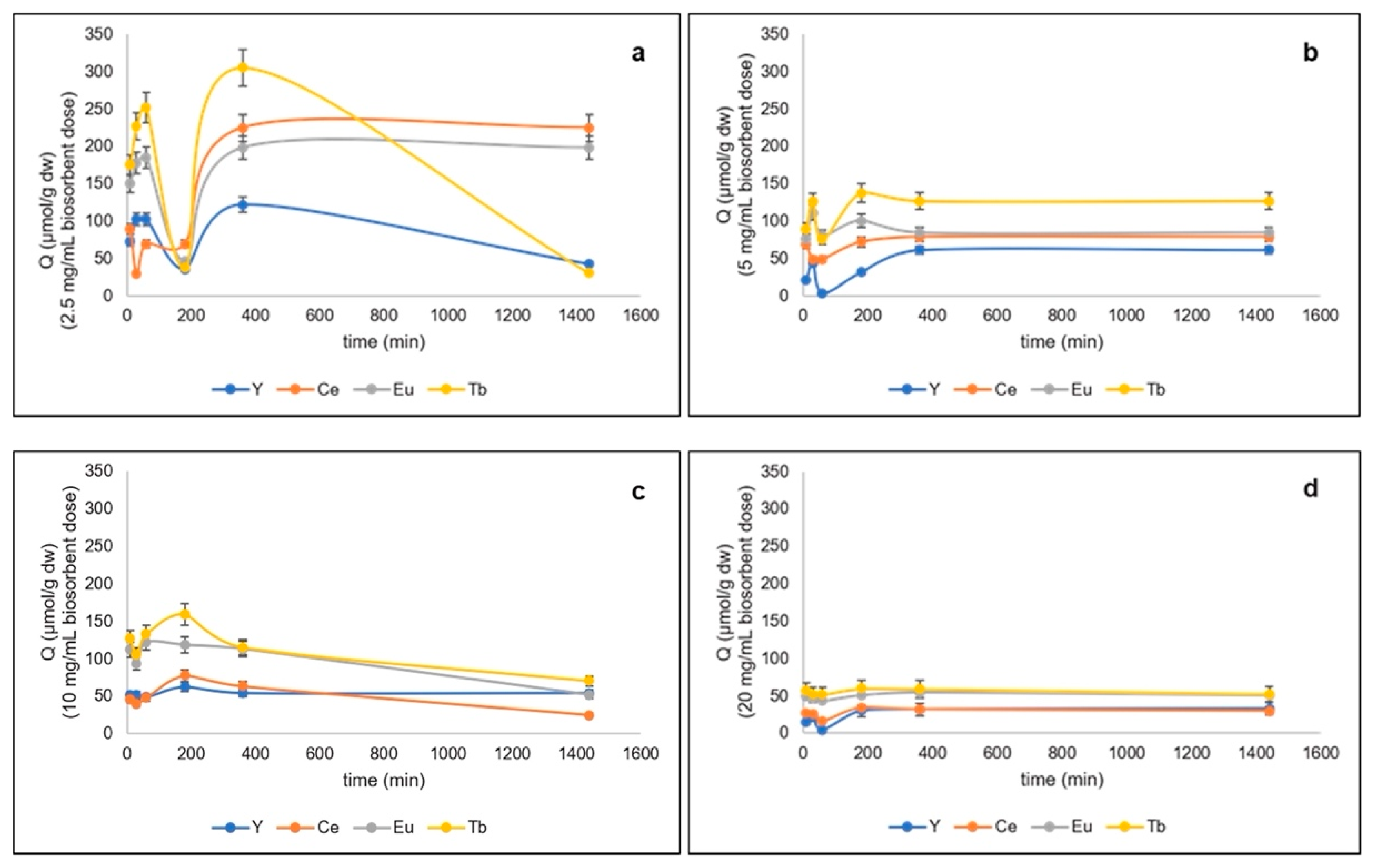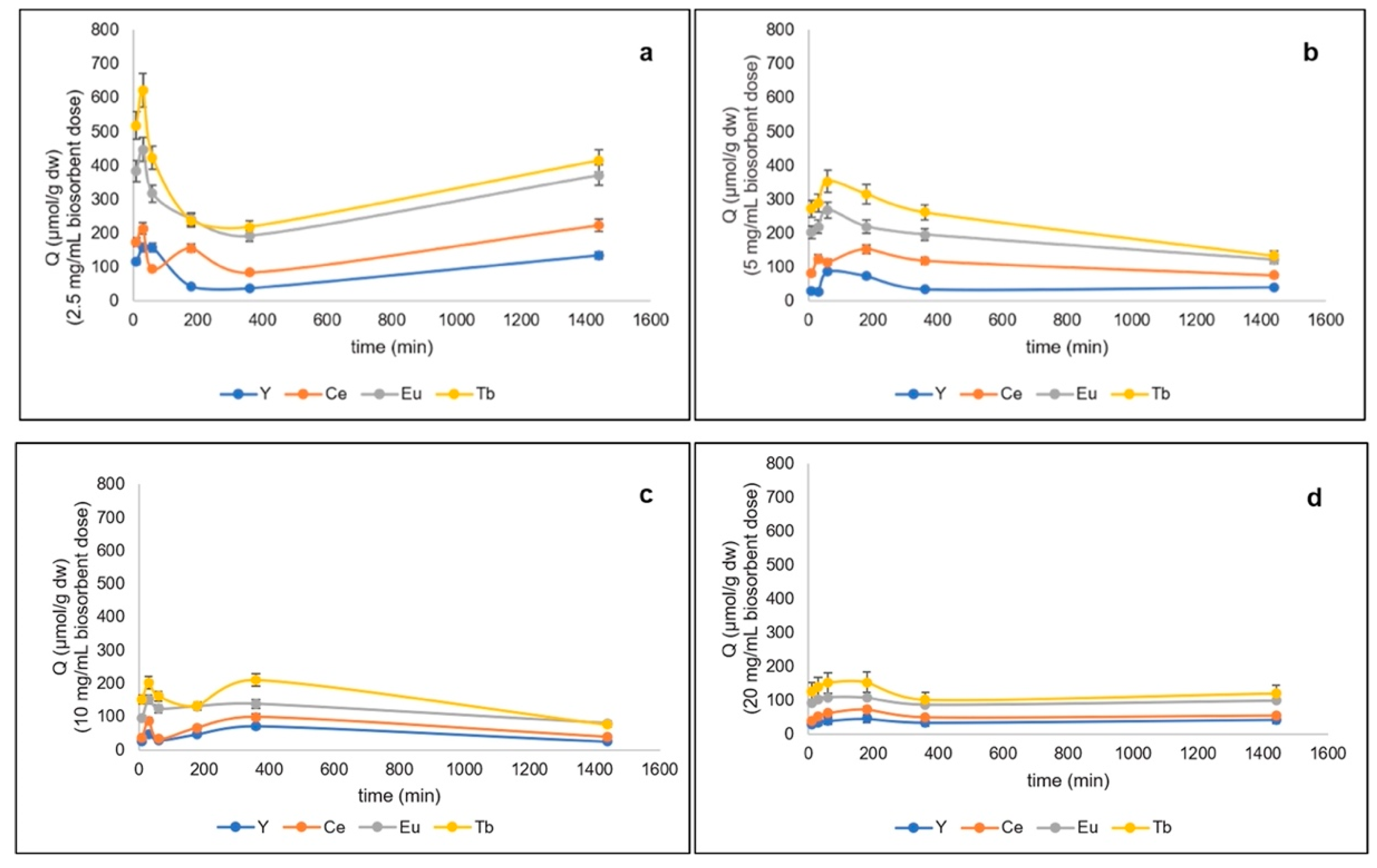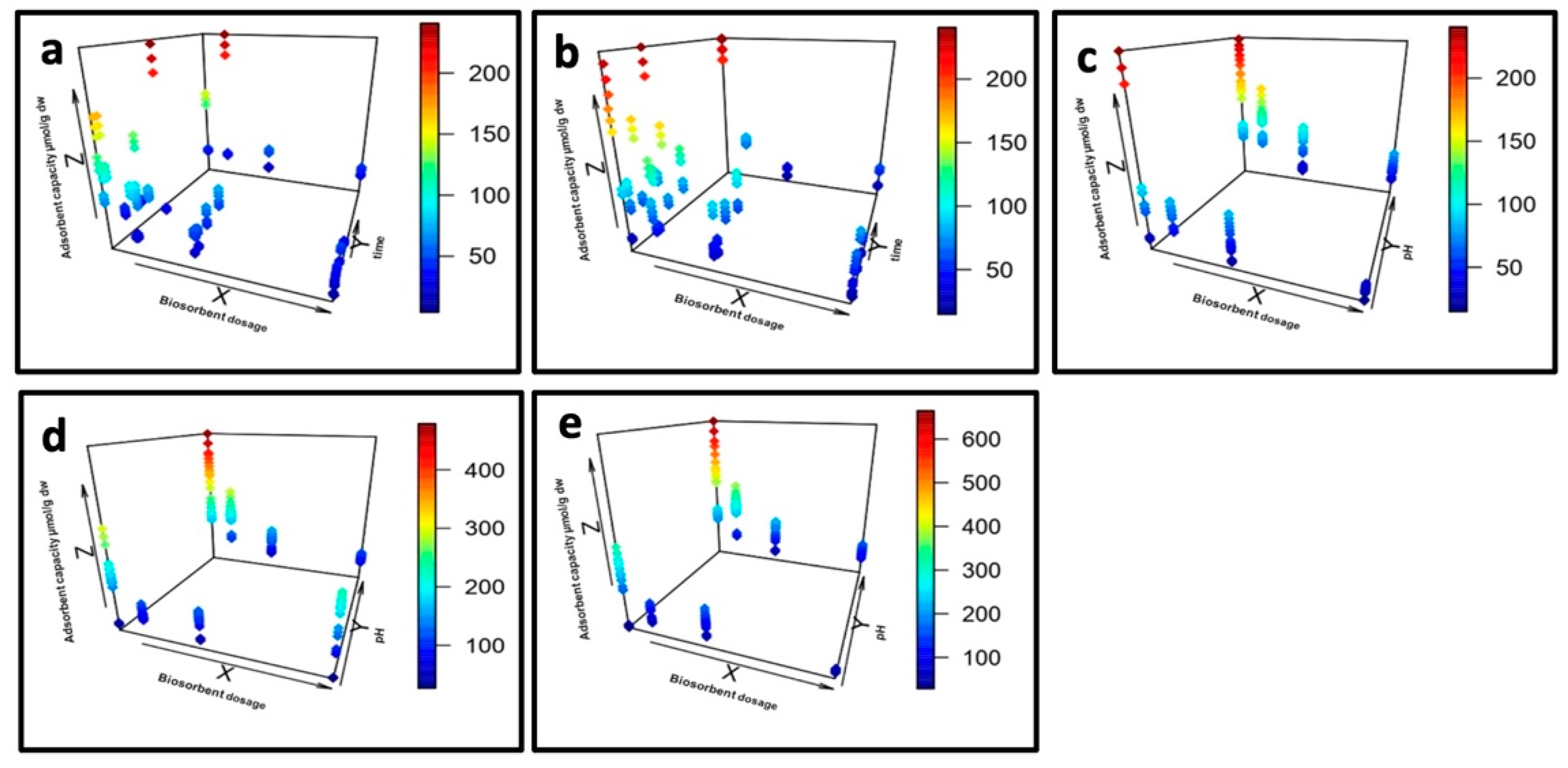Galdieria sulphuraria ACUF427 Freeze-Dried Biomass as Novel Biosorbent for Rare Earth Elements
Abstract
:1. Introduction
2. Materials and Methods
2.1. Metals Stock Solutions
2.2. Microalgal Culture Preparation
2.3. Metal Uptake Experiments
2.4. Mathematical Analyses
2.5. Statistical Analyses
3. Results
3.1. Removal of Y3+, Ce3+, Eu3+, and Tb3+ in Quaternary Metal Systems at pH 2.5
3.2. Removal of Y3+, Ce3+, Eu3+, and Tb3+ in Quaternary Metal Systems at pH 4.5
3.3. The Effect of Variables on the Adsorption Capacity of G. sulphuraria for Rare Metals
4. Discussion
Author Contributions
Funding
Institutional Review Board Statement
Informed Consent Statement
Data Availability Statement
Conflicts of Interest
References
- Volesky, B.; Holan, Z. Biosorption of heavy metals. Biotechnol. Prog. 1995, 11, 235–250. [Google Scholar] [CrossRef] [PubMed]
- Das, N. Recovery of precious metals through biosorption—A review. Hydrometallurgy 2010, 103, 180–189. [Google Scholar] [CrossRef]
- Pollmann, K.; Kutschke, S.; Matys, S.; Raff, J.; Hlawacek, G.; Lederer, F.L. Bio-recycling of metals: Recycling of technical products using biological applications. Biotechnol. Adv. 2018, 36, 1048–1062. [Google Scholar] [CrossRef] [PubMed]
- Almomani, F.; Bohsale, R.R. Bio-sorption of toxic metals from industrial wastewater by algae strains Spirulina platensis and Chlorella vulgaris: Application of isotherm, kinetic models and process optimization. Sci. Total Environ. 2021, 755, 142654. [Google Scholar] [CrossRef]
- Minoda, A.; Sawada, H.; Suzuki, S.; Miyashita, S.I.; Inagaki, K.; Yamamoto, T.; Tsuzuki, M. Recovery of rare earth elements from the sulfothermophilic red alga Galdieria sulphuraria using aqueous acid. Appl. Microbiol. Biotechnol. 2015, 99, 1513–1519. [Google Scholar] [CrossRef]
- Ramasamy, D.L.; Porada, S.; Sillanpää, M. Marine algae: A promising resource for the selective recovery of scandium and rare earth elements from aqueous systems. Chem. Eng. J. 2019, 371, 759–768. [Google Scholar] [CrossRef]
- Zhang, J.; Zhao, C.; Sun, S.; Zhao, Y.; Liu, J. Performance of different microalgae-based technologies in nutrient removal and biogas upgrading in response to various GR24 concentrations. Int. Biodeterior. Biodegrad. 2021, 158, 105166. [Google Scholar] [CrossRef]
- di Cicco, M.R.; Palmieri, M.; Lubritto, C.; Ciniglia, C. Microalgae-Based Nutrient Recovery from Urban Wastewater. In Algal Biorefineries and the Circular Bioeconomy; CRC Press: Boca Raton, FL, USA, 2022; pp. 115–145. ISBN 9781003195429. [Google Scholar]
- Daubert, L.N.; Brennan, R.A. Passive remediation of acid mine drainage using crab shell chitin. Environ. Eng. Sci. 2007, 24, 1475–1480. [Google Scholar] [CrossRef] [Green Version]
- Ishikawa, S.I.; Sekine, S.; Miura, N.; Suyama, K.; Arihara, K.; Itoh, M. Removal of selenium and arsenic by animal biopolymers. Biol. Trace Elem. Res. 2004, 102, 113–127. [Google Scholar]
- Dodson, J.R.; Parker, H.L.; García, A.M.; Hicken, A.; Asemave, K.; Farmer, T.J.; He, H.; Clarka, J.H.; Hunt, A.J. Bio-derived Materials as a Green Route for Precious & Critical Metal Recovery and Re-use. Green Chem. 2015, 17, 1951–1965. [Google Scholar]
- Du, Z.; Zheng, T.; Wang, P.; Hao, L.; Wang, Y. Fast microwave-assisted preparation of a low-cost and recyclable carboxyl modified lignocellulose-biomass jute fiber for enhanced heavy metal removal from water. Bioresour. Technol. 2016, 201, 41–49. [Google Scholar] [CrossRef]
- Saha, S.; Murray, P. Exploitation of Microalgae Species for Nutraceutical Purposes: Cultivation Aspects. Fermentation 2018, 4, 46. [Google Scholar] [CrossRef]
- Shi, L.; Wei, D.; Ngo, H.H.; Guo, W.; Du, B.; Wei, Q. Application of anaerobic granular sludge for competitive biosorption of methylene blue and Pb(II): Fluorescence and response surface methodology. Bioresour. Technol. 2015, 194, 297–304. [Google Scholar] [CrossRef]
- Wang, B.; Zhu, Y.; Bai, Z.; Luque, R.; Xuan, J. Functionalized chitosan biosorbents with ultra-high performance, mechanical strength and tunable selectivity for heavy metals in wastewater treatment. Chem. Eng. J. 2017, 325, 350–359. [Google Scholar] [CrossRef]
- Xin, S.; Zeng, Z.; Zhou, X.; Luo, W.; Shi, X.; Wang, Q.; Deng, H.; Du, Y. Recyclable Saccharomyces cerevisiae loaded nanofibrous mats with sandwich structure constructing via bio-electrospraying for heavy metal removal. J. Hazard. Mater. 2017, 324, 365–372. [Google Scholar] [CrossRef]
- di Cicco, M.R.; Palmieri, M.; Altieri, S.; Ciniglia, C.; Lubritto, C. Cultivation of the acidophilic microalgae galdieria phlegrea with wastewater: Process yields. Int. J. Environ. Res. Public Health 2021, 18, 2291. [Google Scholar] [CrossRef]
- di Cicco, M.R.; Iovinella, M.; Palmieri, M.; Lubritto, C.; Ciniglia, C. Extremophilic Microalgae Galdieria Gen. for Urban Wastewater Treatment: Current State, the Case of “POWER” System, and Future Prospects. Plants 2021, 10, 2343. [Google Scholar] [CrossRef]
- di Cicco, M.R.; Masiello, A.; Spagnuolo, A.; Vetromile, C.; Borea, L.; Giannella, G.; Iovinella, M.; Lubritto, C. Real-Time Monitoring and Static Data Analysis to Assess Energetic and Environmental Performances in the Wastewater Sector: A Case Study. Energies 2021, 14, 6948. [Google Scholar] [CrossRef]
- Ciniglia, C.; Yang, E.C.; Pollio, A.; Pinto, G.; Iovinella, M.; Vitale, L.; Yoon, H.S. Cyanidiophyceae in Iceland: Plastid rbc L gene elucidates origin and dispersal of extremophilic Galdieria sulphuraria and G. maxima (Galdieriaceae, Rhodophyta). Phycologia 2014, 53, 542–551. [Google Scholar] [CrossRef] [Green Version]
- Eren, A.; Iovinella, M.; Yoon, H.S.; Cennamo, P.; de Stefano, M.; de Castro, O.; Ciniglia, C. Genetic structure of Galdieria populations from Iceland. Polar Biol. 2018, 41, 1681–1691. [Google Scholar] [CrossRef]
- Iovinella, M.; Lombardo, F.; Ciniglia, C.; Palmieri, M.; di Cicco, M.R.; Trifuoggi, M.; Race, M.; Manfredi, C.; Lubritto, C.; Fabbricino, M.; et al. Bioremoval of Yttrium (III), Cerium (III), Europium (III), and Terbium (III) from Single and Quaternary Aqueous Solutions Using the Extremophile Galdieria sulphuraria (Galdieriaceae, Rhodophyta). Plants 2022, 11, 1376. [Google Scholar] [CrossRef]
- Bonificio, W.D.; Clarke, D.R. Rare-Earth Separation Using Bacteria. Environ. Sci. Technol. Lett. 2016, 3, 180–184. [Google Scholar] [CrossRef]
- Mehta, S.K.; Tripathi, B.N.; Gaur, J.P. Enhanced sorption of Cu2+ and Ni2+ by acid-pretreated Chlorella vulgaris from single and binary metal solutions. J. Appl. Phycol. 2002, 14, 267–273. [Google Scholar] [CrossRef]
- Allen, M.M.; Stanier, R.Y. Selective Isolation of Blue-green Algae from Water and Soil. J. Gen. Microbiol. 1968, 51, 203–209. [Google Scholar] [CrossRef] [Green Version]
- Ostroumov, S.A.; Shestakova, T.V.; Tropin, I.V. Biosorption of copper by biomass of extremophilic algae. Russ. J. Gen. Chem. 2015, 85, 2961–2964. [Google Scholar] [CrossRef]
- Miyashita, S.; Ogura, T.; Fujii, S.; Inagaki, K.; Takahashi, Y.; Minoda, A. Effect of lyophilization on the acid resistance of a unicellular red alga Galdieria sulphuraria during platinum recovery. J. Hazard. Mater. Adv. 2021, 3, 100015. [Google Scholar] [CrossRef]
- Miyashita, S.I.; Ogura, T.; Kondo, T.; Fujii, S.I.; Inagaki, K.; Takahashi, Y.; Minoda, A. Recovery of Au from dilute aqua regia solutions via adsorption on the lyophilized cells of a unicellular red alga Galdieria sulphuraria: A mechanism study. J. Hazard. Mater. 2022, 425, 127982. [Google Scholar] [CrossRef]
- Sirakov, M.; Palmieri, M.; Iovinella, M.; Davis, S.J.; Petriccione, M.; di Cicco, M.R.; De Stefano, M.; Ciniglia, C. Cyanidiophyceae (Rhodophyta) Tolerance to Precious Metals: Metabolic Response to Palladium and Gold. Plants 2021, 10, 2367. [Google Scholar] [CrossRef]
- Oliveira, R.; Palmieri, M.; Garcia, O. Biosorption of Metals: State of the Art, General Features, and Potential Applications for Environmental and Technological Processes. Prog. Biomass Bioenergy Prod. 2011, 151–176. [Google Scholar] [CrossRef] [Green Version]
- Oliveira, R.C.; Garcia, O. Study of biosorption of rare earth metals (La, Nd, Eu, Gd) by Sargassum sp. biomass in batch systems: Physicochemical evaluation of kinetics and adsorption models. Adv. Mater. Res. 2009, 71–73, 605–608. [Google Scholar] [CrossRef]
- Richards, R.G.; Mullins, B.J. Using microalgae for combined lipid production and heavy metal removal from leachate. Ecol. Modell. 2013, 249, 59–67. [Google Scholar] [CrossRef] [Green Version]
- Chojnacka, K.W. Bioaccumulation of Cr(III) ions by Blue-Green alga Spirulina sp. Part I. A Comparison with Biosorption Investigation of properties of designed biocomposite hydrogel capsules for precise release of micronutrients. Am. J. Agric. Biol. Sci. 2007, 2, 218–223. [Google Scholar] [CrossRef]
- Arunakumara, K.K.I.U.; Zhang, X. Heavy metal bioaccumulation and toxicity with special reference to microalgae. J. Ocean Univ. China 2007, 7, 60–64. [Google Scholar] [CrossRef]
- Lingamdinne, L.P.; Chang, Y.Y.; Yang, J.K.; Singh, J.; Choi, E.H.; Shiratani, M.; Koduru, J.R.; Attri, P. Biogenic reductive preparation of magnetic inverse spinel iron oxide nanoparticles for the adsorption removal of heavy metals. Chem. Eng. J. 2017, 307, 74–84. [Google Scholar] [CrossRef]
- Nakkeeran, E.; Rangabhashiyam, S.; Giri Nandagopal, M.S.; Selvaraju, N. Removal of Cr(VI) from aqueous solution using Strychnos nux-vomica shell as an adsorbent. Desalin. Water Treat. 2016, 57, 23951–23964. [Google Scholar] [CrossRef]
- Verma, A.; Kumar, S.; Kumar, S. Biosorption of lead ions from the aqueous solution by Sargassum filipendula: Equilibrium and kinetic studies. J. Environ. Chem. Eng. 2016, 4, 4587–4599. [Google Scholar] [CrossRef]



| Metal | Biosorbent Dosage (mg/mL) | Time (min) | Maximum AdsorptionCapacity (µmol/g dw) | |
|---|---|---|---|---|
| pH 2.5 | Y | 2.5 | 360 | 122.02 ± 13.42 |
| Ce | 2.5 | 360 | 224.90 ± 17.60 | |
| Eu | 2.5 | 360 | 198.05 ± 15.20 | |
| Tb | 2.5 | 360 | 305.27 ± 28.50 | |
| Total | 850.24 ± 92.13 | |||
| pH 4.5 | Y | 2.5 | 10 | 158.07 ± 22.67 |
| Ce | 2.5 | 30 | 214.03 ± 19.58 | |
| Eu | 2.5 | 30 | 447.23 ± 38.51 | |
| Tb | 2.5 | 30 | 621.16 ± 5.21 | |
| Total | 1440.50 ± 136.87 |
| Parameters | Df | Sum Sq | Mean Sq | F Value | Pr (>F) | |
|---|---|---|---|---|---|---|
| Yttrium | pH | 1 | 3635 | 3635 | 2.087 | 0.1509 |
| Biomass | 1 | 86,458 | 86,458 | 49.637 | 8.4e−11*** | |
| Time | 1 | 5207 | 5207 | 2.989 | 0.0861 | |
| pH: Biomass | 1 | 3543 | 3543 | 2.034 | 0.1561 | |
| pH: Time | 1 | 6600 | 6600 | 3.789 | 0.0537 | |
| Biomass: Time | 1 | 201 | 201 | 0.115 | 0.7349 | |
| pH: Biomass: Time | 1 | 713 | 713 | 0.410 | 0.5233 | |
| Residuals | 136 | 236,886 | 1742 | |||
| Cerium | pH | 1 | 34,038 | 34,038 | 21.004 | 1.03e−05*** |
| Biomass | 1 | 147,468 | 147,468 | 90.999 | <2e−16*** | |
| Time | 1 | 8846 | 8846 | 5.459 | 0.02093* | |
| pH: Biomass | 1 | 1146 | 1146 | 0.707 | 0.40187 | |
| pH: Time | 1 | 6931 | 6931 | 4.277 | 0.04053* | |
| Biomass: Time | 1 | 13,147 | 13,147 | 8.112 | 0.00508** | |
| pH: Biomass: Time | 1 | 5585 | 5585 | 3.447 | 0.06554 | |
| Residuals | 136 | 220,394 | 1621 | |||
| Europium | pH | 1 | 125,995 | 125,995 | 28.705 | 3.50e−07*** |
| Biomass | 1 | 185,178 | 185,178 | 42.188 | 1. 44e−09*** | |
| Time | 1 | 259 | 259 | 0.059 | 0.808 | |
| pH: Biomass | 1 | 213,672 | 213,672 | 48.680 | 1.20e−10*** | |
| pH: Time | 1 | 30,832 | 30,832 | 7.024 | 0.009** | |
| Biomass: Time | 1 | 2761 | 2761 | 0.629 | 0.429 | |
| pH: Biomass: Time | 1 | 40 | 40 | 0.009 | 0.925 | |
| Residuals | 136 | 596,953 | 4389 | |||
| Terbium | pH | 1 | 580,111 | 580,111 | 90.781 | <2e−16*** |
| Biomass | 1 | 603,437 | 603,437 | 94.431 | <2e−16*** | |
| Time | 1 | 86,475 | 86,475 | 13.532 | 0.000337*** | |
| pH: Biomass | 1 | 105,981 | 105,981 | 16.585 | 7.86e−05*** | |
| pH: Time | 1 | 7605 | 7605 | 1.190 | 0.277233 | |
| Biomass: Time | 1 | 22,892 | 22,892 | 3.582 | 0.60525 | |
| pH: Biomass: Time | 1 | 12 | 12 | 0.002 | 0.965907 | |
| Residuals | 136 | 869,075 | 6390 |
Publisher’s Note: MDPI stays neutral with regard to jurisdictional claims in published maps and institutional affiliations. |
© 2022 by the authors. Licensee MDPI, Basel, Switzerland. This article is an open access article distributed under the terms and conditions of the Creative Commons Attribution (CC BY) license (https://creativecommons.org/licenses/by/4.0/).
Share and Cite
Palmieri, M.; Iovinella, M.; Davis, S.J.; di Cicco, M.R.; Lubritto, C.; Race, M.; Papa, S.; Fabbricino, M.; Ciniglia, C. Galdieria sulphuraria ACUF427 Freeze-Dried Biomass as Novel Biosorbent for Rare Earth Elements. Microorganisms 2022, 10, 2138. https://doi.org/10.3390/microorganisms10112138
Palmieri M, Iovinella M, Davis SJ, di Cicco MR, Lubritto C, Race M, Papa S, Fabbricino M, Ciniglia C. Galdieria sulphuraria ACUF427 Freeze-Dried Biomass as Novel Biosorbent for Rare Earth Elements. Microorganisms. 2022; 10(11):2138. https://doi.org/10.3390/microorganisms10112138
Chicago/Turabian StylePalmieri, Maria, Manuela Iovinella, Seth J. Davis, Maria Rosa di Cicco, Carmine Lubritto, Marco Race, Stefania Papa, Massimiliano Fabbricino, and Claudia Ciniglia. 2022. "Galdieria sulphuraria ACUF427 Freeze-Dried Biomass as Novel Biosorbent for Rare Earth Elements" Microorganisms 10, no. 11: 2138. https://doi.org/10.3390/microorganisms10112138
APA StylePalmieri, M., Iovinella, M., Davis, S. J., di Cicco, M. R., Lubritto, C., Race, M., Papa, S., Fabbricino, M., & Ciniglia, C. (2022). Galdieria sulphuraria ACUF427 Freeze-Dried Biomass as Novel Biosorbent for Rare Earth Elements. Microorganisms, 10(11), 2138. https://doi.org/10.3390/microorganisms10112138










